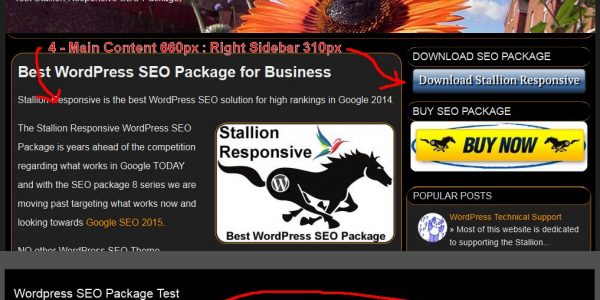Comment on Stallion Responsive SEO Theme Layout Options by SEO Dave.

As you’ve touched on there’s a time issue, setting 6 phrases as you write a new article is manageable, editing hundreds of posts, not so easy!
If you already do keyword research (like I do) when creating an article it doesn’t take long to generate 6 phrases rather than one or two, barely any time at all for me.
If you look through my articles like the Future SEO article and note the headers I tend to use (H2 and H3s) you’ll find the Stallion keyphrases tend to be used as a header as well.
The Future of SEO articles keyphrases etc…
WordPress Post Title : The Future of SEO
All In One SEO Title : SEO 2015
Stallion Keyphrase 1 : Google SEO 2015
Stallion Keyphrase 2 : Search Engine Optimization 2015
Stallion Keyphrase 3 : Google Search Engine Optimization 2015
Stallion Keyphrase 4 : 2015 SEO
The Future of SEO articles headers.
H1 = SEO 2015
H2 = Google SEO 2015 History
H3 = Google Search Engine Optimization Difficulty
H3 = 2015 SEO : Performance and Usability
H3 = The Future of SEO 2015
The H1 is added by Stallion Responsive automatically, it will use the All In One SEO Title if set or the WordPress Post Title if not.
The H2 and H3 headers are manually added by me.
I loosely try to match the Stallion keyphrases to the manually added H2 and H3 headers.
You can see Stallion Keyphrase 1 is part of the H2.
Stallion Keyphrase 4 and the WordPress Post Title is part of two of the H3s.
Some parts of Stallion Keyphrase 2 and 3 are part of other H3s.
I don’t have a specific plan which keyphrases to add as a H3 etc…, try to match the content to the keyphrases and a keyphrases to the content. I tend to add one H2 and as many H3s as make sense for the content. Sometimes I’ll add H4s as well.
With the above approach I’m already doing keyword research to determine which phrases to target to add to the content including within the headers. Using the same keyword research to generate the Stallion keyphrases at the same time is easy. If I add a header I’ll look for a phrase to add as a keyphrase or if I want to use a particular keyphrase I’ll try to add it as a header as well. But it’s not a strict MUST add XYZ headers and keyphrases…
When dealing with user comments I use the same concept for comment titles, but much, much more loosely. I might use some of the Stallion keyphrases (or derivative) as the title of a comment, if it works (try to match the comment title to the articles SERPs and to the actual comment body text).
For this comment title I’m using “Google Search Engine Optimization Guide 2015” to so you can see what I mean. If this where a comment under the The Future of SEO article (I may well move this comment thread there later ** :-)) it will help with the main articles SERPs, because the comments content matches the articles SERPs.
** I use a couple of plugins for moving comments around and changing the threading: “Move WordPress Comments” and “Tako Movable Comments”. Don’t worry about the SEO implications of moving comments around, in Stallion Responsive 8 (or was it 8.1) added a canonical URL to the Stallion SEO Super Comments so Google automatically sorts out the indexing correctly.
Regarding the duplicate links. From reading what Google has released I believe if #something is missing from say 5 duplicate links they count as one link from the page, so only counting unique links. When #something is part of the URL it’s not completely clear how much link benefit is passed, there are indications each link passes link benefit even though they go to the same webpage, they are unique URLs. So 5 links with unique #something added to the URL could pass 5 sets of link benefit to one webpage, they certainly pass 5 sets of anchor text benefit.
I assume each link is counted as unique.
I consider this at worst SEO neutral and IMO SEO positive.
When linking from say a category you want as many links as possible to be relevant to the category, when looking at a category you can have three unique and SEO optimized links to each article (if you have the Comment link it’s one more, but that’s not SEO’d anchor text). I consider this a positive, your categories have more anchor text from them that target the sort of SERPs you want your categories to rank for, if you have a lot of unrelated links on sidebars the extra category links will add SEO value to the category SERPs.
If you silo SEO your popular and recent posts widgets like I do those are also a positive. Go to any post on this site and look at the anchor text of the popular and recent posts widget, it tends to use similar keywords as the post you are on. Go to another post in another category and the links and anchor text from the popular and recent posts widget change and tend to be similar to the post you are on. See the SEO Silo Post for more details.
All that being said it’s about priorities, with a site like yours I’d slowly modify all the posts overtime (could take years) and would prioritize your most important posts first. Maybe a case of every day edit one post and some of it’s comments titles (modify the big comments only). With 2,000 posts in a year you could have most of your important posts optimized without it being a case of ONLY spending your time modifying old posts. You may find some of your older posts are not worth keeping, if so either rewrite or delete and 301 redirect to the most relevant webpage. Given a choice I tend towards rewrite, you have an aged webpage that might have aged backlinks (worth their weight in gold), rewriting could generate new SERPs. If you are deleting consider moving the comments to a relevant post using the comments plugins I mentioned above, I hate loosing user comments, feel wrong to delete them.
On my site over the past 6 months I’ve moved something like 180 posts from other sites (that is time consuming moving posts and setting up redirects etc…) including almost 4,000 comments. I’ve rewrote over half the posts, re done all the keyword research from scratch and checked/modified every comment title, moved comments to the most relevant article whilst still maintaining 130 domains, finishing a Stallion Responsive update (8.1), getting 1/4 way through the 8.2 update and doing a bunch of other stuff.
What I’ve done here should really pay off early next year when the domain has aged.
David


More Comments by SEO Dave
WordPress SEO Theme Layout
WordPress Clone Plugins and SEO Theme Options
There’s isn’t an export Stallion SEO settings per se, you could of course clone a site which will cone everything if you plan to build a lot of new sites that can save a lot of time: setup one empty …
Continue Reading WordPress SEO Theme Design
WordPress SEO Theme Layout
How to Make WordPress Custom Page Templates
It’s relatively easy to make custom page templates for WordPress and especially easy with Stallion Responsive.
You have two choices.
Use the example template (made for this reason) and modify to your needs, that’s the file page-example.php
This is basically the page.php template …
Continue Reading WordPress SEO Theme Design
WordPress SEO Theme Layout
WordPress Static Page HomePage
That’s just a static page.
Created a WordPress Static Page, added content as you do :-)
“Settings” >> “Reading”
Tick “A static page (select below)”
Select the WordPress Static Page I made.
I did create a new WordPress Custom Page Template for this page which …
Continue Reading WordPress SEO Theme Design
WordPress SEO Theme Layout
SEO Posts Widget Image Links
Regarding the SEO Posts widget linked thumbnail images, if you’ve updated to Stallion Responsive 8.1 you can limit the number of thumbnail images like you see on my left sidebar.
I have the popular posts widget and the recent posts widget …
Continue Reading WordPress SEO Theme Design
WordPress SEO Theme Layout
SEO WordPress Strategy 2015
For usability reasons (users come first) I wouldn’t remove the link part of the images, it would likely confuse site visitors.
Looking at your site amishamerica.com you aren’t using Stallion Responsive to it’s full SEO capabilities.
For example the links you are …
Continue Reading WordPress SEO Theme Design
WordPress SEO Theme Layout
WordPress Design Layouts
There’s dozens of Stallion layouts and color schemes each with their own CSS files, so depends what layout and color schemes you’ve set.
You’ll find all CSS files under /stallion-seo-theme/colors/ basically a site will use one layout file and one color …
Continue Reading WordPress SEO Theme Design
WordPress SEO Theme Layout
Disable WordPress Search Form
The header search form isn’t a widget it’s built in to the theme, to disable go to
Stallion Layout Options : Search Form OFF
This activates the Header Widget Area so you can add something else there via a widget: there’s limited …
Continue Reading WordPress SEO Theme Design
WordPress SEO Theme Layout
Comments WordPress Page Templates
Disabling comments on a post is a core WordPress feature, on the edit page there’s a setting.
There’s a Stallion feature under the Stallion Layout options page to turn all dates and author links sitewide off, no built in way to …
Continue Reading WordPress SEO Theme Design
WordPress SEO Theme Layout
WordPress Theme Copyright Notice Date
Changing the copyright date isn’t a theme option, it’s based on the date of your earliest post.
That being said if you don’t mind changing code, I suppose you could add any date by replacing this code with any date:
The file …
Continue Reading WordPress SEO Theme Design
WordPress SEO Theme Layout
WordPress Responsive Theme CSS Max-Width of Images
That’s a WordPress responsive theme CSS setting called max-width within the Stallion layout CSS files so images never stretch over the sidebars.
Under /stallion-seo-theme/colors/ you’ll find the layout CSS files name format layout-***.css where the *** relates to the layout used, …
Continue Reading WordPress SEO Theme Design
WordPress SEO Theme Layout
SEO Content High in Code
In SEO theory having your most important content higher in the code as possible makes sense, BUT the actual evidence it matters a lot is weak at best.
If there is an SEO impact it’s very small.
There is an argument loosing …
Continue Reading WordPress SEO Theme Design
WordPress SEO Theme Layout
SEO vs Website Design
I completely agree, the difficulty is creating a great looking page without it costing on the SEO side.
Easy to take everything away from the home page with Stallion via the Page templates, but take out all the sidebar links etc… …
Continue Reading WordPress SEO Theme Design